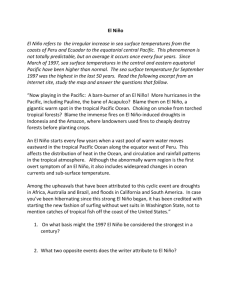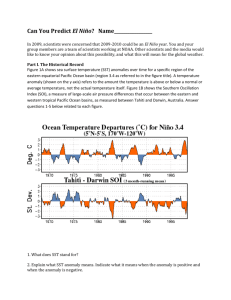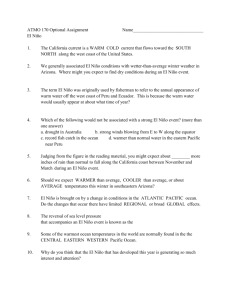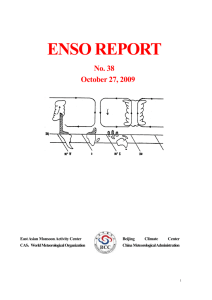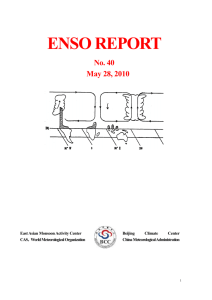English
advertisement
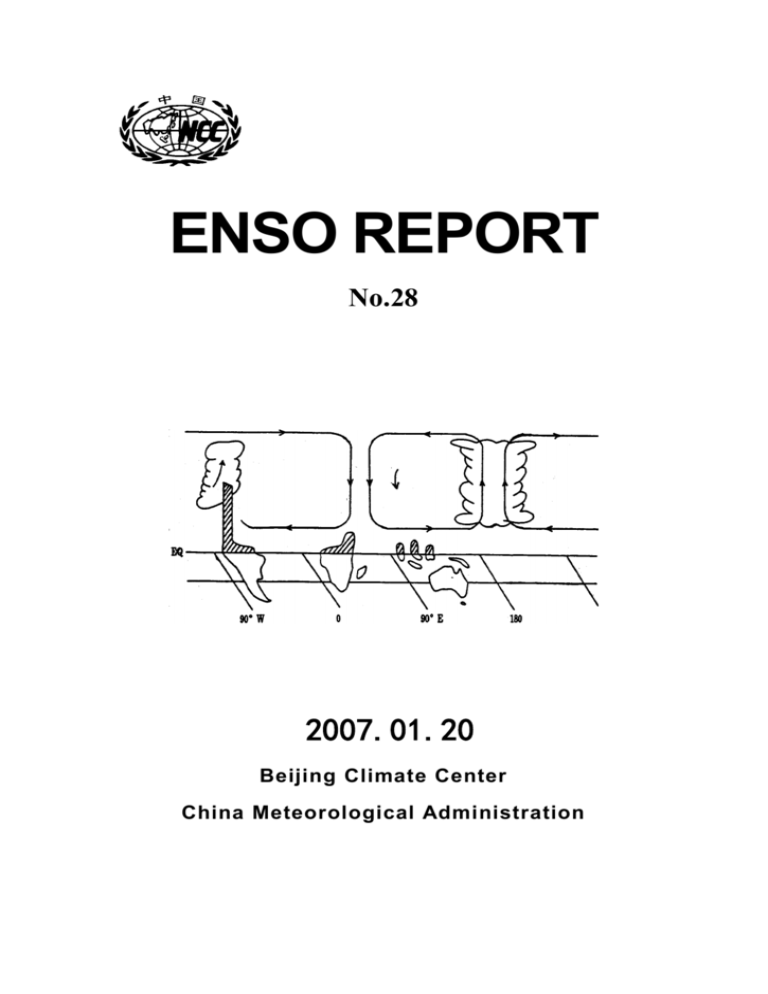
ENSO REPORT No.28 2007.01.20 Beijing Climate Center China Meteorological Administration An El Niño event came into being, and it is expected to persist in the following 2~3 moths. 1,Monitoring for recent oceanic and atmospheric conditions (1) Sea Surface Temperatures Anomalies (SSTa) and Southern Oscillation (SOI) The positive SSTa emerged in the central-eastern equatorial Pacific and rose gradually since May 2006, and the SSTa above 0.5ºC were observed in most of the central-eastern equatorial Pacific in August. From August to December 2006, Niño Z index was greater than 0.5℃ for 5 consecutive months, and its accumulative value has exceeded 4.0℃. Meanwhile, SOI shifted from the positive value to the negative in May 2006, and it persisted negative value from May to December except November. Monitoring result shows, an El Niño event came into being. 1.5 1 0.5 0 -0.5 -1 -1.5 -2 SOI Nino Z -2.5 -3 1 2 3 4 5 6 7 8 9 10 11 12 1 2 3 4 5 6 7 8 9 10 11 12 2006 2005 Fig.1 Variations of Niño Z index (Unit: ℃) and SOI (2) Subsurface Sea Temperatures During December, the positive anomalies of subsurface sea temperature above 1℃ maintained in most of the central-eastern tropical Pacific. Compared with the situation in November, positive anomalies in the central-eastern tropical Pacific weakened and shifted eastward and upward during December. Meanwhile, negative anomalies in the western tropical Pacific strengthened and extended eastward (Fig.2). Fig.2 Equatorial depth-longitude section of monthly mean ocean temperature anomalies 2006.11(left) 2006.12(right) (℃) From July to October 2006, most of the western equatorial Pacific was covered by weak westerly anomalies at 850hPa. During November, it turned to be easterly anomalies and strengthened in December. Meanwhile, weak westerly anomalies sustained over the most central-eastern tropical Pacific at 850hPa since May 2006, but it weakened rapidly during December. 2 1.5 135º E- 180 175º W- 120º W 1 0.5 0 -0.5 -1 -1.5 -2 1 2 3 4 5 6 7 8 9 10 11 12 1 2 3 4 5 6 7 8 9 10 11 12 2005 2006 Fig.3 Variation of indices for regional zonal wind over the equatorial Pacific at 850hPa (4) Convections Since August 2006, the anomalous outgoing long-wave radiation (OLR) showed that convections were suppressed over the western part of the equatorial western Pacific and slightly enhanced over the equatorial Pacific from 160ºE to the date line (Fig.4). Fig.4 Time-longitude section of monthly mean equatorial OLR anomalies 2, Effects of El Niño on climate El Niño affects on global climate through air-sea interaction. There exists potential relationship between El Niño and some recent abnormal climate event. For example, heavy rains raided eastern Africa frequently during August to November 2006, temperatures above normal were observed in northeastern America from December 2006 to early January 2007, rainstorm raided northern Peru during January 2007, etc. The composite maps of temperature anomalies and precipitation percentage anomalies in China for El Niño winter are shown in fig.5. Usually, positive temperature anomalies were observed in most regions except for northern Northeast China, northern North China, eastern and northeastern Northwest China and most of Tibet. Meanwhile, precipitations were above normal in most of region south to the Yangtse River, the region between the Yellow River and Huaihe, central-western Inner Mongolia, most of Northwest China and northern Northeast China. And precipitation were below normal in southern Northeast China, central China, western Xinjiang and southwestern Tibet. Although El Niño has a major influence on climate, there is still uncertain due to the complexity of climate system. It should be specifically treated rather than generally for each El Niño event. (a) (b) Fig.5 Composites of temperature anomalies (a) (0.1℃) and precipitation percentage anomalies (b) (%) in China for El Niño winters 3, Outlook There are 3 El Niño events (1951, 1963, 1986/1987) break out during July to September since 1951, except for the strong El Niño event in 1986/1987, the other two are both weak. The atmospheric conditions during the 1986/1987 El Niño event shows distinct westerly anomalies maintained over western tropical Pacific at 850hPa and SOIs persisted negative from October 1986 to December 1987, which were suitable for the El Niño development. Meanwhile, from November to December 2006, easterly anomalies covered western tropical Pacific at 850hPa and SOI fluctuated near zero. All the main ENSO indicators show that El Niño event has begun to weaken. According to the ENSO dynamic and statistical models of BCC (Beijing Climate Center) and other countries, most of them show indices of Niño 3 will maintain above 05℃ but weaken in next 3 months. Fig.6 Prediction of ENSO statistical model of BCC (Beijing Climate Center ) Based on diagnosing recent tropical oceanic and atmospheric conditions, historical analog analysis, most dynamic and statistical model’s predictions, a synthetically outlook is drawn out: A weak-moderate El Niño event came into being, and it is expected to persist in the following 2~3 months. Definition for El Niño and La Niña Event in BCC’s Operation * El Niño: A phenomenon occurs in the equatorial mid-eastern Pacific Ocean, which is characterized by a positive sea-surface temperature departure from normal (for the 1971-2000 base period) in Nino Z (Nino 1+2+3+4) greater than or equal to 0.5℃ for at least 6 consecutive months (allowing below 0.5℃ for only one month) . La Niña: A phenomenon occurs in the equatorial mid-eastern Pacific Ocean, which is characterized by a negative sea-surface temperature departure from normal (for the 1971-2000 base period) in Nino Z (Nino 1+2+3+4) smaller than or equal to -0.5℃ for at least 6 consecutive months (allowing above 0.5℃ for only one month) . *References 1. On Indices and Indicator of ENSO Episodes, 2000, Acta Meteorogica Sinica, 58(1): 102-109 2. Redefining ENSO Episode on Changed Reference, 2005, Journal of Tropical Meteorology, 2005, 21(1): 72-78 Distribution of the Niño regions for ENSO monitoring



